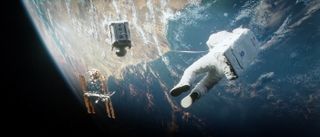In 'Gravity,' International Space Station Co-Stars with Sandra Bullock

The new Warner Bros. movie "Gravity" stars Sandra Bullock, George Clooney — and the International Space Station.
The space station plays a key role in "Gravity," which opened Friday (Oct. 4) and features two astronauts struggling for survival after their spacecraft is destroyed by debris. The interior of their craft has a number of ties to actual experiments performed aboard the orbiting laboratory.
In preparation for her role, Bullock spoke with astronaut Catherine "Cady" Coleman to discuss Bullock's character and what life is like in microgravity. A NASA video shows Bullock and Coleman together, reminiscing about their collaboration. [See Photos from the new film "Gravity"]
"I told her that I had long hair, and if you pulled a hair out and pushed it against something, you could move yourself across the space station," Coleman said in a statement following an advanced screening. "That's how little force it takes."
A key element in the movie is fire, which scientists study aboard the International Space Station. Conditions in space allow researchers to gain a better understanding of how fuel burns and flames function.
The Burning and Suppression of Solids investigation, for example, may contribute to improved fire suppression methods for spacecraft, while the Flame Extinguishment Experiment, which recently led to the discovery of cool flames, may lead to improved fuel efficiency on Earth.
"Things burn in a different way in space, allowing us to understand the mechanism of burning itself — how soot is produced, how pollution happens," Coleman said. "Things happen more slowly, so we are able to better measure them."
Get the Space.com Newsletter
Breaking space news, the latest updates on rocket launches, skywatching events and more!
Beads of water in the film are formed via special effects, but in space, water forms spheres without any help from Hollywood. The Capillary Flow Experiment is helping to predict liquid behavior in microgravity, which helps to build better groundwater transportation and cooling capabilities for electronics on Earth, and applies to the design of space-bound fuel tanks.
Plant life also makes an appearance in space, much as it does on the station.
"I was pleased to have the movie show something that we actually do on the space station," Coleman said.
Coleman worked with biology investigations on the space station, monitoring the mouse-ear cress for its response to the stresses of space as part of Plant Growth Investigations in Microgravity. Such investigations are a step toward the space station's Vegetable Production System (Veggie) facility, where the crew will eventually grow more robust plants to eat.
"Up in space, we are forced to grow things in an alternative way," Coleman said. "Just growing them in the dirt is not always the most logistically feasible option. In trying to understand those lessons, we learn how to minimize resources and still grow something."
These experiments have far-reaching applications as astronauts travel to more distant locations.
"If we are going to Mars, we are not going to be able to bring everything we need to eat," Coleman said. "This is why it's important to understand how to grow food in space."
Although the film focuses on the destruction of a spacecraft, NASA works hard to protect its astronauts from the dangers seen on screen. Protective material coats the outside of the space station, while astronauts are trained to cover a wide variety of potential catastrophes.
"This isn't a documentary; it's a movie," Coleman said. "It transports people from this planet into space. I am really lucky, as an astronaut, to go and live there."
She pointed out that the work done aboard the space station goes far beyond entertainment, touching on the very nature of the human spirit.
"Our planet sits in a neighborhood within the universe, and we are all space explorers," Coleman said. "I think space movies, in general, bring that message home to us. Whether we live with our feet on the planet or whether we live on the space station, we are all space travelers, and we are a people of space exploration."
Follow us @Spacedotcom, Facebook or Google+. Originally published on SPACE.com.
Join our Space Forums to keep talking space on the latest missions, night sky and more! And if you have a news tip, correction or comment, let us know at: community@space.com.

Nola Taylor Tillman is a contributing writer for Space.com. She loves all things space and astronomy-related, and enjoys the opportunity to learn more. She has a Bachelor’s degree in English and Astrophysics from Agnes Scott college and served as an intern at Sky & Telescope magazine. In her free time, she homeschools her four children. Follow her on Twitter at @NolaTRedd
